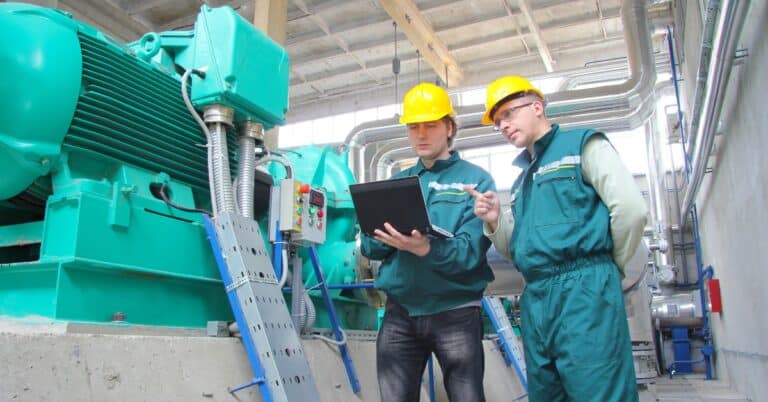A well-run lubrication management program is critical to the smooth operation of any industrial facility. By implementing a comprehensive lubrication management program, you can keep your equipment running efficiently and avoid costly downtime. However, many organizations struggle to optimize their lubrication because they just don’t know where to begin. There are so many pieces to lubrication management that, even if you take a course, you might still leave unsure of what comes next. In this blog post, we’ll take a closer look at the components of an effective lubrication management program. We’ll also discuss some best practices for achieving optimal results.
A Holistic Approach to Lubrication Management
What is lubrication management? For many, it is a list of all the equipment and the recommended product for each. Yes, that is unquestionably important to do. However, there is much more to excellent lubrication than just choosing the right lubricant for the job at hand. A more holistic approach to lubrication management is growing in popularity. And, the organizations that implement it have benefited from the impact.
Lubrication Management Core Components
The first perspective shift for a more holistic approach is to see lubricants as assets rather than consumables to purchase at the lowest price. With the right nurturing and management, lubricants can provide great benefits to your business, just like any other asset. With that in mind, a lubricant’s nurturing process begins with its arrival on site, up until it is drained and disposed of appropriately. There are many factors to consider along the way, so these are the core components of your holistic lubrication management program:
- Procurement, Standardization, and even Consolidation of Lubricants
- Storage and Handling of Lubricants
- Oil Sampling Techniques
- Contamination and Cleanliness Control
- Training
- Lubricant Analysis
- Lubrication and Relubrication Best Practices
- Lubrication Program Management
- Guidelines and Procedures
- Goals, Metrics, and/or Key Performance Indicators (KPIs)
- Program Safety
- Proper Disposal
- Continuous Improvement Plan
To be effective, lubrication management programs must assess all these areas and make improvements where necessary to bring current practices in line with industry best practices.
Why Do You Need a Comprehensive Lubrication Management Plan?
If you invest millions of dollars in revenue-generating assets, particularly your equipment and machinery, you want to protect that investment. To ensure the greatest reliability and output, these machines depend on proper maintenance procedures carried out by professionals using high-quality materials. Moreover, one of the most vital maintenance activities is lubrication management for your equipment to be protected from excessive wear.
In addition to improving worker safety and productivity, a well-thought-out lubrication management program decreases the time, effort, and money required. Join us for an educational webinar with guest Tim Dunton from Reliability Solutions as he will cover the 5 Steps to Maintaining a Successful Lubrication Program.
How to Integrate Every Component with Lubrication Management Software
Lubrication management software can give you the structure, support, and insight to make every piece of your lubrication management program work together. And, it puts everything you and your technicians need to get the job done in the palm of your hand with access from any mobile device, including offline capability.
Lubrication Charting
Every lubrication point in your plant can be charted and organized efficiently, complete with supplementary images, written instructions, documentation, lubricant specifications, relubrication schedules, and expected completion times. This enables you to develop an easy-to-implement complete lubrication management strategy. With streamlined workflows and time-saving automation, you can standardize lubrication for all of your assets. Even better, you can have our certified lubrication team do the charting for you and have a turnkey program in a matter of weeks, eliminating the guesswork from developing your lubrication program.
Lubricant Inventory Management
Your lubricant inventory can be managed more accurately with the help of software. By having technicians update inventory in real time when lubrication tasks are completed, you enhance inventory accuracy.
Condition Monitoring Integration
Your lubrication management isn’t complete without condition monitoring to keep you on track and guide your continuous improvement. But, the issue many organizations have is the overwhelming amount of data from condition monitoring sensors and equipment. With lubrication management software, you can have a comprehensive, multidimensional feedback system by integrating data from various condition-monitoring technologies, such as oil analysis, vibration analysis, thermography, and ultrasonics. The software integrates with established business management systems, sensors, GPS trackers, and even oil analysis labs.
This streamlines your monitoring and management of hundreds of assets by automating alerts according to custom thresholds that you set. Additionally, once a condition passes a threshold, the software can trigger a preset workflow such as creating a task for inspection or relubrication and assigning it to a technician.
Lubrication Data and Insights at Your Fingertips
What is the relationship between data and lubricant management? If you don’t have accurate records of what has occurred, you have nothing to go on when trying to prevent future issues. Without data, you remain stuck in a reactive state, unsure of the root cause of equipment problems. Lubrication management software puts all of your data at your fingertips. Real-time syncing means you can quickly and easily evaluate asset and lubricant conditions to make strategic decisions or modify your preventive maintenance (PM). Furthermore, by modifying PM templates and making changes to numerous assets in minutes, you can optimize your lubrication program quickly and finally get a return on your investment.

Where to Begin?
While it may be tempting to tackle every problem at once, holistic lubrication management is a long-term strategy. Most maintenance departments are facing rising prices, supply chain issues, skilled labor shortages, and tight budgets. So, identify the areas that could save you the most money and tackle those first! Or, is there a lubrication problem that is causing a critical asset to have excessive downtime? Start there. As long as you have a plan for continuous improvement of your lubrication management, you can’t go wrong by starting somewhere. If you’d like to see how our team at Redlist can support you on your lubrication management journey, schedule a demo today.



